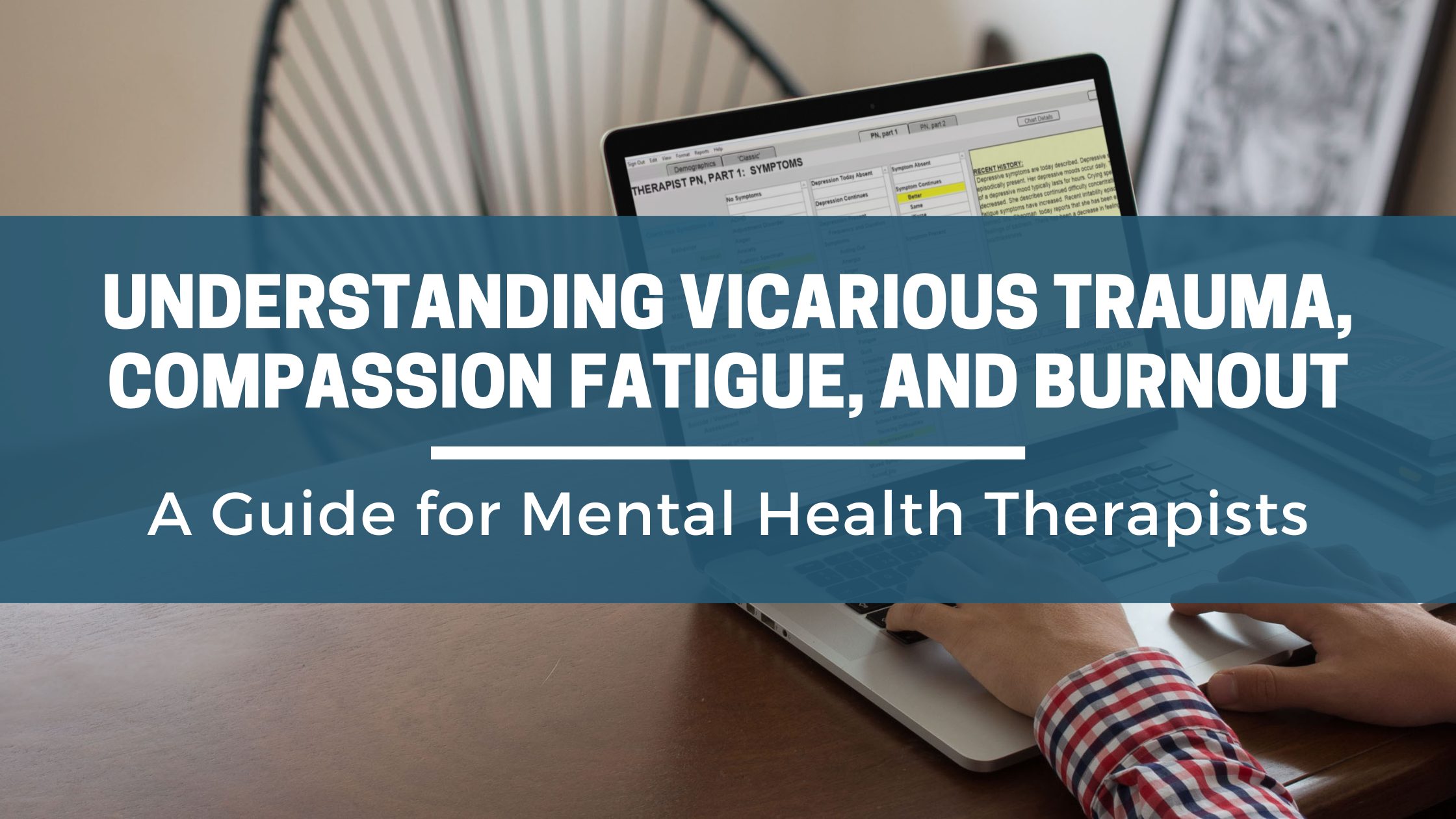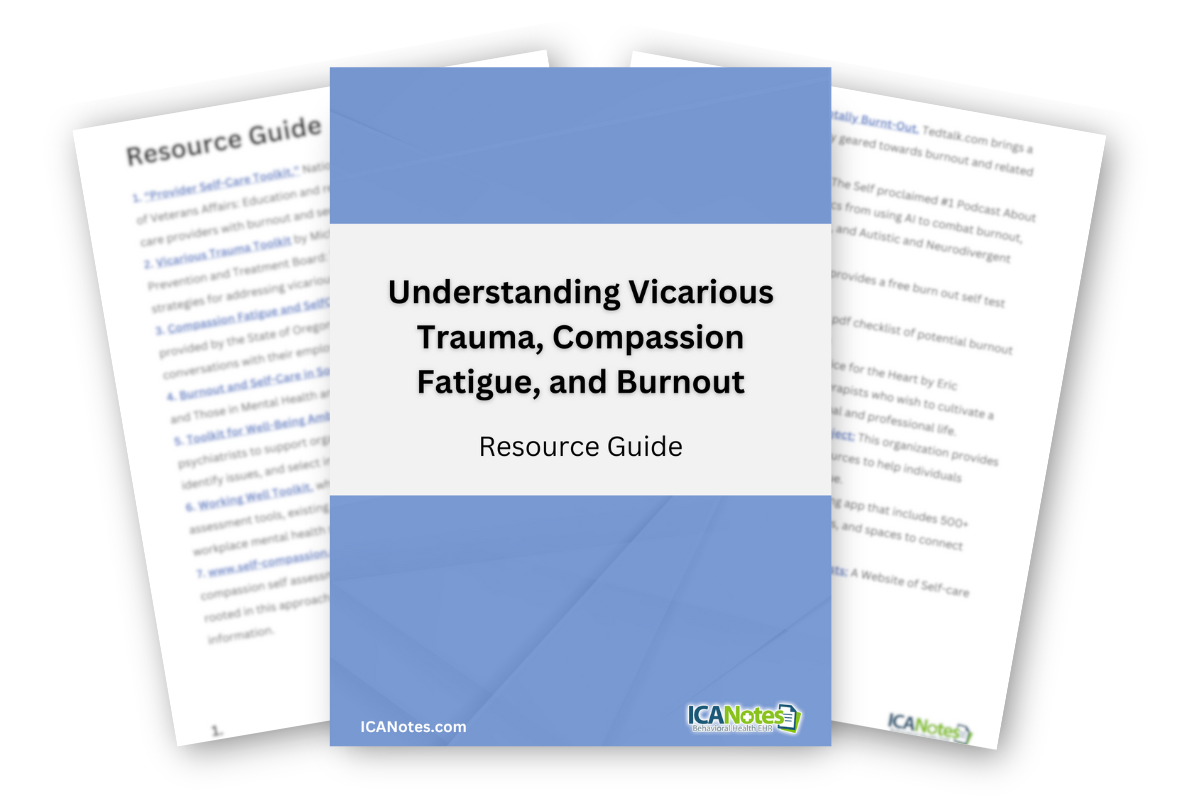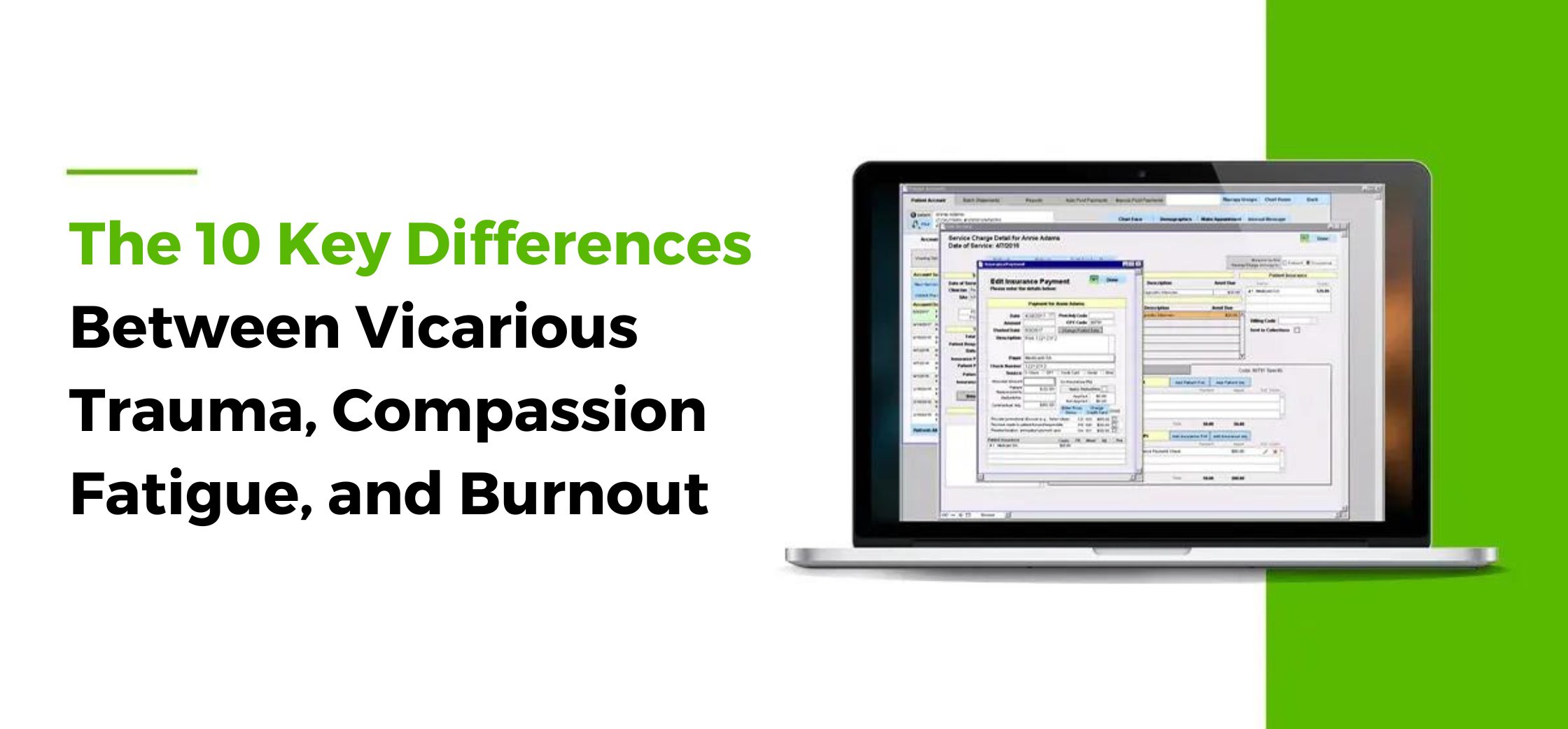
Understanding Vicarious Trauma and Compassion Fatigue versus Burnout
As a mental health provider, you may find yourself drawn to the profession because of your innate desire to help others. You provide a safe space for clients to share personal experiences and emotions, no matter how uncomfortable they may be. However, the emotional toll of this kind of “helping” can be overwhelming and lead to feelings of exhaustion, detachment, and cynicism. The Institute for Public Health (2012) reports between 40 and 85% of helping professionals have developed vicarious trauma and compassion fatigue and/or high rates of traumatic symptoms at least one point in their career.
The mental health community has also experienced incredible change since the COVID-19 pandemic, SAMHSA reporting in 2022 that over 50% of Behavioral Health Providers reported experiencing burnout in the last year. Three terms commonly used to describe this emotional state are vicarious trauma, compassion fatigue, and burnout. While often used interchangeably, they describe different experiences that require unique strategies for prevention and treatment. Let’s explore the differences between vicarious trauma, compassion fatigue, and burnout, and discuss strategies to mitigate the risks of experiencing them.
Free Vicarious Trauma and Compassion Fatigue Resource Guide
A compilation of various tools, materials, and sources designed to support and assist behavioral health clinicians in managing the challenges of vicarious trauma and compassion fatigue.

What is Vicarious Trauma?
Vicarious trauma is a psychological response that occurs when providers are repeatedly exposed to the traumatic experiences and stories of their patients. Vicarious trauma specifically involves experiencing symptoms similar to post-traumatic stress disorder (PTSD) as a result of empathetic absorption of their patients' trauma. This can include intrusive thoughts, nightmares, emotional numbness, avoidance, heightened anxiety/hyperarousal, and disrupted belief systems.
What is Compassion Fatigue?
Compassion fatigue, often called “the high cost of caring,” refers to the emotional and physical exhaustion that mental health professionals may experience due to continuous exposure to their clients' suffering and trauma, leading to a reduced capacity for empathy. It is a state of emotional numbness and decreased ability to connect with clients' emotions, due to the cumulative stress of providing care and support to individuals facing mental health challenges. Compassion fatigue occurs when mental health professionals become overwhelmed by the emotional demands of their work, leading to feelings of hopelessness, sadness, and a loss of satisfaction in their roles. This state is characterized by a sense of helplessness and a diminished sense of purpose in providing care. Compassion fatigue can manifest as physical symptoms such as headaches, fatigue, and sleep disturbances.
What is Burnout?
Burnout is a psychological syndrome marked by emotional exhaustion, depersonalization (a lack of empathy and detachment from clients), and reduced personal accomplishment. It occurs when providers are persistently overwhelmed by high levels of stress, workload, and demands, leading to a sense of emptiness and cynicism in their work. Burnout can result in feelings of emotional depletion, as providers struggle to manage the emotional intensity of their clients' issues and maintain their well-being. It is often characterized by a loss of motivation and a decline in the quality of care provided, as professionals become disengaged from their clients and their job satisfaction diminishes. 21-67% of mental health workers may be experiencing high levels of burnout. In a study of 151 community mental health workers in California, Webster, and Hackett found that 54% had high emotional exhaustion, and 38% reported high depersonalization rates, but most reported high levels of personal accomplishment as well.

The 10 Key Differences Between Vicarious Trauma, Compassion Fatigue and Burnout
1. Nature of Emotional Response:
Vicarious Trauma
Involves experiencing symptoms similar to PTSD due to exposure to clients' trauma.
Compassion Fatigue
Results from empathetic over-absorption of clients' suffering and may decrease empathy.
Burnout
Is a general feeling of emotional exhaustion and detachment, not necessarily tied to clients' suffering.
2. Emotional Exhaustion:
Vicarious Trauma
Primarily stems from the emotional demands of absorbing clients' traumatic experiences.
Compassion Fatigue
Arises from high levels of empathizing with clients and their distress.
Burnout
Results from a broader range of stressors, including workplace demands and personal factors.
3. Relationship with Clients:
Vicarious Trauma
Impacts the mental health professionals' emotional well-being and ability to provide effective support.
Compassion Fatigue
Affects the emotional connection with clients and may lead to decreased empathy.
Burnout
Influences overall engagement and motivation at work, including interactions with clients.
4. Specific Triggers
Vicarious Trauma
Triggered by exposure to clients' traumatic experiences and stories.
Compassion Fatigue
Triggered by empathetic engagement with clients' suffering.
Burnout
Triggered by chronic workplace stress, overwhelming demands, and broader life factors.
5. Physical Symptoms
Vicarious Trauma
May manifest with specific physical symptoms related to emotional distress.
Compassion Fatigue
Can lead to emotional and physical symptoms due to the toll of empathetic caregiving.
Burnout
Often results in physical symptoms resembling those of depression and chronic stress. A study of 591 social workers in NY found that high levels of burnout, particularly emotional exhaustion and depersonalization were related to greater reports of flu-like symptoms and symptoms of gastroenteritis, Acker (2010).
6. Onset and Recovery Time
Vicarious Trauma
May develop relatively quickly after intense exposure to trauma and often requires time away from traumatic content to recover.
Compassion Fatigue
Develops over time and also benefits from breaks and self-care.
Burnout
Typically develops gradually due to chronic stress and may require a more extended break and comprehensive recovery approach. Depending on the severity, recovery time can take anywhere from a few weeks to even a few years.
7. Work Satisfaction
Vicarious Trauma
Mainly affects satisfaction with the emotional aspects of the job.
Compassion Fatigue
Impacts job satisfaction, particularly in emotional engagement with clients.
Burnout
Affects overall job satisfaction, including motivation and a sense of purpose.
8. Preventive Measures:
Vicarious Trauma
Prevention involves strategies to manage exposure to traumatic content and self-care.
Compassion Fatigue
Focuses on managing empathetic caregiving and promoting self-care.
Burnout
Prevention addresses workplace stress, workload, and holistic self-care.
9. Perceived Purpose:
Vicarious Trauma
May still retain a sense of purpose in helping clients but struggle with the emotional toll.
Compassion Fatigue
Professionals may question their ability to make a difference due to emotional fatigue.
Burnout
Often leads to a sense of hopelessness and a loss of purpose in both work and life.
10. Scope of Impact
Vicarious Trauma
Specific and focused on the emotional response to traumatic content.
Compassion Fatigue
Emotionally focused but also affects the ability to provide effective care.
Burnout
Broader in scope, impacting overall well-being and functioning, both professionally and personally.
These differences demonstrate that while vicarious trauma, compassion fatigue, and burnout share some similarities, they have distinct triggers, manifestations, and implications for mental health professionals. Recognizing these differences is key for addressing, preventing, and treating each condition.
Can You Experience Vicarious Trauma and Compassion Fatigue Simultaneously?
Absolutely. Mental health providers facing any combination of these conditions may require more comprehensive support, including therapy, self-care strategies, and potential adjustments to their work environments to regain emotional wellness, job satisfaction, and the ability to provide effective care. Recognizing the complex interplay of these is crucial for mental health providers and their organizations to implement effective interventions and support systems to help them cope and recover.
Three things to know about mental health professionals experiencing compassion fatigue, vicarious trauma, and burnout simultaneously:
1. Complex Interplay: Compassion fatigue, vicarious trauma, and burnout can be experienced simultaneously, as these conditions often interact and exacerbate each other due to the intense emotional demands of their work.
2. Intense Emotional Toll: When these conditions co-occur, providers may face an overwhelming emotional toll due to the demands of their work, the emotional intensity of their clients' issues, and their exposure to traumatic content. The symptoms of these can impact a provider's life outside of work, leading to a diminished capacity for care in their personal lives as well.
3. Higher Risk for Mental Health Issues: The co-occurrence of compassion fatigue, vicarious trauma, and burnout increases the risk of mental health professionals developing mental health problems, such as anxiety, depression, and symptoms resembling post-traumatic stress disorder (PTSD).
How Common are Compassion Fatigue, Vicarious Trauma, and Burnout Among Mental Health Professionals?
Prevalance
- The American Psychological Association reports studies estimating 21-61% of mental health professionals report symptoms of Burnout at some point in their careers. SAMHSA (2012) reports one study showing 78% of psychiatrists reporting burnout in 2017.
- The National Association of Social Workers reports up to 70% of social workers will experience Compassion Fatigue.
- Vicarious Trauma was observed at high frequencies among mental health providers who had prolonged exposure to traumatic client stories, especially in roles dealing with trauma survivors. The National Child Traumatic Stress Network reports that studies show up to 26% of therapists working with traumatized populations and up to 50% of child welfare workers report secondary traumatic stress.
High-Stress Environments
Mental health professionals working in high-stress environments, such as crisis intervention or trauma therapy, were more likely to experience burnout, compassion fatigue, and vicarious trauma. SAMHSA (2012) reports a study in which prevalence rates of burnout among substance abuse counselors were 33%, and 65% of opioid treatment program counselors reported symptoms of burnout.
Years of Experience
Mental health professionals with more years of experience in the field were sometimes found to have a higher risk of experiencing burnout, possibly due to cumulative stress. This can also apply to vicarious trauma. A 2000’s study showed that of 29 directors of community mental health centers in Iowa, over two-thirds reported high emotional exhaustion and low personal accomplishment. Almost half reported high levels of depersonalization. (SAMHSA, 2012)
Influence of Caseload
The size and complexity of caseloads could impact the prevalence of all three conditions, with professionals dealing with larger caseloads at greater risk of injury experiencing these symptoms. The Institute for Public Health reports that professionals with client bases consisting of 60% or more clients with a significant trauma history are at an increased risk for experiencing secondary trauma.
Risk of Secondary Traumatic Stress
Mental health professionals working with clients who have experienced trauma may have a higher risk of developing secondary traumatic stress, a component of compassion fatigue and vicarious trauma.
Other Impacting Factors
- Greater shortages of behavioral health providers (especially in rural settings); SAMSHA (2012) reports that about 13 percent of rural counties have no access to psychologists, psychiatrists, psychiatric nurse practitioners, social workers, or counselors.
- Increased mental health needs; The American Psychological Association reports that over 50 percent of psychologists reported seeing more clients for anxiety, depression, and trauma/stress-related disorders compared to before the COVID-19 pandemic.
- SAMHSA (2012) continues by identifying the top 5 reported organizational factors impacting burnout as; unfair treatment at work, unmanageable workload, lack of role clarity, lack of communication/support from leadership, and unreasonable time pressure.
Self-Care and Burnout Management, Ethical Considerations
The impacts of burnout, vicarious trauma and compassion fatigue affect more than just the provider. These conditions and their symptoms ripple in impact to clients, organizations, and even communities. SAMHSA (2022) highlights these issues within various Codes of Ethics and Conduct. The APA Code of Conduct requires clinicians to take steps to stop working if their ability to provide is impeded. The Social Work Code of Ethics states that social workers address and confront symptoms of burnout individually but also directly with their coworkers. In 2021 they amended their code to include Professional Self-Care as an ethical social work practice.
How to Treat, Prevent, and Manage Burnout, Compassion Fatigue and Vicarious Trauma
Prevention and Treatment
- Set Boundaries: Establish clear boundaries between work and personal life to prevent overextension. Be mindful of your caseload and workload, and don't hesitate to ask for help or delegate when necessary to prevent the onset of compassion fatigue, vicarious trauma, and burnout. Evaluate structuring stronger boundaries surrounding your emotional and physical energy and mental wellness needs.
- Supervision and Consultation: Regularly engage in supervision or consultation with colleagues to process challenging cases and seek guidance for managing emerging symptoms.
- Self-Care Routine: Develop and invest in a true self-care routine that prioritizes your emotional and mental well-being and provides support in managing the emotional toll of your work. Brene Brown cites “non-doing play” as an anecdote for feelings of being overwhelmed.
Management
- Self-Compassion: Cultivate self-compassion and remind yourself that it's okay to have limitations and seek help when needed.
- Delegate and Collaborate: Collaborate with colleagues and delegate tasks to avoid taking on too much responsibility.
- Variety in Work: If possible, vary your caseload to include a mix of challenging and less emotionally taxing cases.
- Switching Roles/Placement/Population: Consider switching roles, placements, or client populations periodically to prevent emotional burnout.
Prevention, treatment, and management strategies can vary from person to person, so it's important to find what works best for you. Mental health providers must be aware and practice ongoing mindfulness regarding their self-care and coping while working such an emotionally taxing job. Here are some free and accessible resources to help you identify the strategies that will serve you in your personal and professional life.
Six Essential Self-Care Domains for Mental Health Professionals
In “Dear Mental Health Practitioners, Take Care of Yourselves: a Literature Review on Self-Care,” authors Kirsten Posluns and Terry Lynn Gall identify six self-care domains with associated strategies that the literature shows to be effective for mental health professionals.
- Awareness: Acceptance and commitment therapy, mindfulness and meditation training, self-reflection, creative writing.
- Balance: Leisure activities, varied work activities (e.g., teaching), non-work related passions, non-work related relationships, holistic approach to health, professional and personal boundaries, time management, taking breaks, flexible work hours and locations, realistic work goals.
- Flexibility: Effective coping strategies, attitude of openness, adaptability, realistic self-expectations, cognitive reappraisal, self-compassion and acceptance, setting and reappraising goals, expressive writing and journaling, acceptance and commitment therapy, professional development.
- Physical Health: Sleep hygiene, balanced diet and hydration, exercise.
- Social Support: (Individual) family, friends, personal therapy (professional) individual or group supervision, professional associations, colleague assistance programs, peer consultation.
- Spirituality: Spiritual connection, prayer, mindfulness, spending time in nature, practicing gratitude, meaning-making, engaging in meaningful work, setting goals with life purpose.
About the Author

Bea Sanders LCSW
Bea Sanders received her Bachelor's and Master's degrees in Social Work from the University of Arkansas, solidifying her commitment to helping individuals and communities flourish. With over a decade of experience, Bea earned her clinical license in 2020 and currently serves as a School-Based Therapist for a Community Mental Health agency. She provides individual, family, and group therapy to adolescents while specializing in innovative therapeutic approaches such as EMDR, ACT, and the Strengths-Based perspective.
Resources
- Substance Abuse and Mental Health Services Administration (SAMHSA): Addressing Burnout in the Behavioral Health Workforce Through Organizational Strategies. SAMHSA Publication No. PEP22-06-02-005. Rockville, MD: National Mental Health and Substance Use Policy Laboratory. Substance Abuse and Mental Health Services Administration, 2022
- National Child Traumatic Stress Network, Secondary Traumatic Stress Committee (2011). Secondary traumatic stress: A fact sheet for child-serving professionals. Los Angeles, CA, and Durham, NC: National Center for Child Traumatic Stress
- Initiative, G. V. (2021, October 29). Professional helpers can experience vicarious trauma.
Institute for Public Health. https://publichealth.wustl.edu/professional-helpers-can-experience-vicarious-trauma/#:~:text=Providers%20may%20react%20physiologically%2C%20emotionally,traumatic%20symptoms%20(Mathieu%2C%202012) - Morse G, Salyers MP, Rollins AL, Monroe-DeVita M, Pfahler C. Burnout in mental health services: a review of the problem and its remediation. Adm Policy Ment Health. 2012 Sep;39(5):341-52. doi: 10.1007/s10488-011-0352-1. PMID: 21533847; PMCID: PMC3156844.
- Practice Research and Policy Staff. (2018, January 25). Research roundup: Burnout in mental health providers. PracticeUpdate. https://www.apaservices.org/practice/update/2018/01-25/mental-health-providers
- National Association of Social Workers (NASW). NASW - National Association of Social Workers. (n.d.). Retrieved July 21, 2022, from https://www.socialworkers.org/About/Ethics/Code-of-Ethics /Highlighted-Revisions-to-the-Code-of-Ethics
- Brown, B. (2021). Atlas of the heart: mapping meaningful connection and the language of human experience. First edition. New York, Random House.
- Posluns K, Gall TL. Dear Mental Health Practitioners, Take Care of Yourselves: a Literature Review on Self-Care. Int J Adv Couns. 2020;42(1):1-20. doi: 10.1007/s10447-019-09382-w. Epub 2019 May 23. PMID: 32435076; PMCID: PMC7223989.
- American Psychological Association (2012). Research roundup: Burnout in mental health providers. https://www.apaservices.org. https://www.apaservices.org/practice/update/2018/01-25/mental-healthproviders#:~:text=Finally%2C%20feelings%20of%20ineffectiveness%20and,et%20al.%2C%202012).











